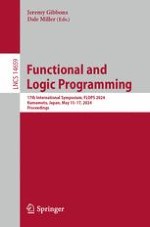2024 | Book | 1. edition
Functional and Logic Programming
17th International Symposium, FLOPS 2024, Kumamoto, Japan, May 15–17, 2024, Proceedings
Editors: Jeremy Gibbons, Dale Miller
Publisher: Springer Nature Singapore
Book Series : Lecture Notes in Computer Science
